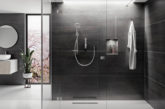
Reports suggest that wall-hung sanitaryware is set to “grow six fold in the next two years”. Abacus Manufacturing Group discusses the changing trends.
Good design and ingenuity are increasingly sought in the UK bathroom market and designers and consumers are now turning to solutions that have long been commonplace in European countries such as Germany and Austria. Nowhere is this truer than with wall-hung sanitaryware which is fast becoming seen as the solution when specifying new bathrooms.
Indeed, there is already considerable growth with wall-hung frame sales significantly up in the last 18 months and leading manufacturers predicting an increase in sales of five to six times in the next two to three years.
The move to wall-hung sanitaryware has been led by the commercial sector, where it has been used for some considerable time. A key contributor to its growth was the change to the UK’s water bylaws on the 1 January 2001 which, for example, removed the need for an external overflow pipe from WCs. In the decade since, the benefits of following European concepts in design and innovation have been better appreciated and adapted to meet UK building techniques by the bathroom industry, opening the way for the use of wall-hung sanitaryware in new build and refurbishment projects at all levels of the market.
Just as has happened with wet rooms, greater customer knowledge and a desire for solutions that offer a contemporary aesthetic, cleanliness and ease of servicing have helped make wall-hung sanitaryware popular. As people travel and visit hotels and spas, they are appreciating first-hand the advantages, in terms of stylish aesthetics and the feeling of space that they can bring to their bathroom and are keen to emulate the high end style that they offer.
This aspiration is enhanced by magazines and TV programmes which are focusing on high quality bathroom design, helping consumers become much more aware of what is available to achieve their dreams.
Further advantages to wall-hung systems can be seen in the solution they can present to mould growth and rot in bathrooms. One reason for these problems is due to condensation on toilet cisterns and water pipes and unlike a traditional ceramic cistern – which acts as a thermal bridge between the cold water and the warm room – these modern options are made of plastic which acts as an insulator. Concealed cisterns have the added benefit of the further insulation provided by the surrounding cabinet or because they are within the wall. This results in an extra thermal break between the water and the room.
Another advantage of wall hung sanitaryware is that the pipes leading to it come from the wall so are insulated rather than – as is the case with basins – running up a pedestal or directly from the floor. In such scenarios, they would be uninsulated and vulnerable to condensation.
Condensation is also an issue with wall surfaces. Here, Abacus Elements and EPS tile backer boards can be considered a solution as they not only waterproof the bathroom and improve U-values but help cut down condensation by preventing thermal bridging from cold external surfaces. Furthermore, in all bathrooms, extractor fans are vital in order to remove moisture.












